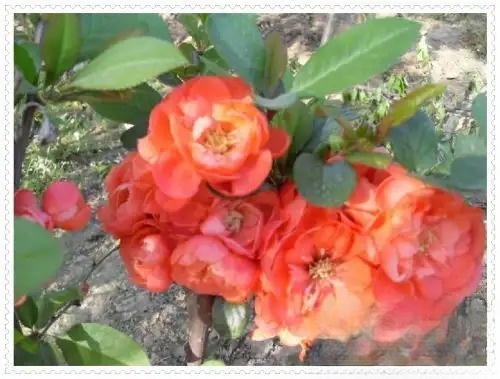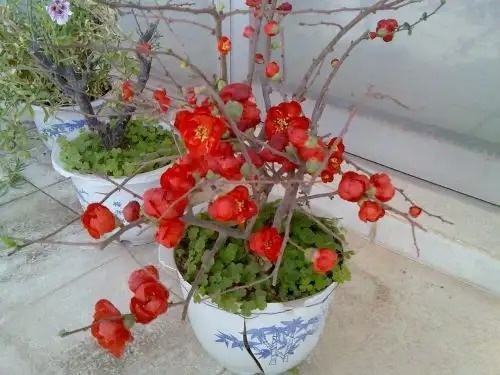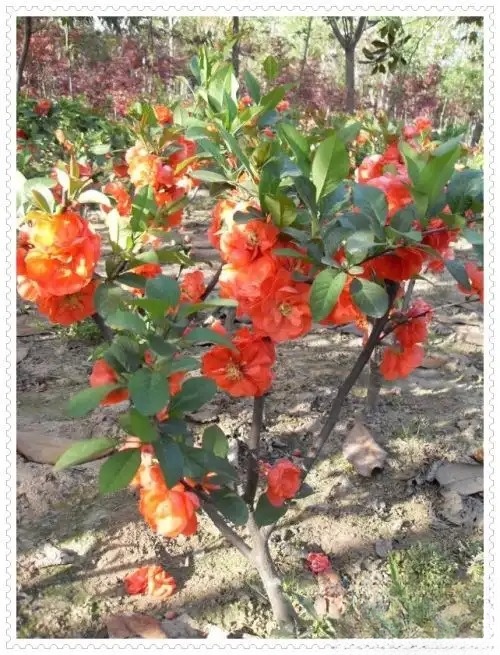Begonia




This seedling is 2 years old
Notes on Japanese quince:
The flowers of Japanese crabapple are very similar to those of Chinese crabapple, but the leaves are slightly thinner. Its stems are mostly clustered and branched, with wart-like protrusions and fine thorns on the branches. The flowers are bright red and pink, and the flowering period is from March to April. Each cluster of flowers consists of several flowers, which are tightly attached to the branches, and are gorgeous and charming. After flowering, spherical fruits are formed, which are yellow and about 3 cm in diameter. It can be planted in courtyards, roadsides, and slopes. It is also often used as a potted plant and placed on balconies and indoors for viewing.
Japanese crabapple likes plenty of sunlight, is also tolerant to semi-shade, and is slightly cold-resistant. Use 5 parts of leaf mold, 3 parts of field soil, and 2 parts of sand to make a culture soil. Acidic and neutral soils are preferred. It grows poorly in saline-alkali soil and clay soil. It likes moisture, but is afraid of waterlogging and root rot. Flower buds form from August to September. At this time, the temperature is relatively high. Avoid large amounts of water and fertilizer. It should be dry and wet, otherwise it is not conducive to flower bud differentiation. Branches can be pruned before germination in spring, cutting off the top and leaving the buds in the middle and lower parts. Propagation is mainly by cuttings, which are carried out in spring and autumn. Cut strong branches about 10 cm long, insert them into plain sandy soil, water them to keep them moist, place them in a shady place, and take root in about 30 days. Transplant them in the spring of the following year. Grafting is also commonly used for propagation, with cutting grafting in spring and grafting from April to July. It can also be propagated by division, which can be carried out in spring and autumn and is easy to survive.
Japanese crabapples are prone to aphids, which can be killed by soaking tobacco leaves in water (soaking overnight). Avoid using dimethoate, otherwise it will cause leaf fall. When the number of domesticated plants is small, they can be eliminated by hand.
Japanese crabapple, also known as papaya crabapple, was introduced from Japan in the 1990s and cultivated by papaya grafting. It is a new family of New Year flowers. The
maintenance and cultivation methods are as follows:
Generally, it is planted in multiple rows, but it can also be made into a pile landscape and potted. The planting period is preferably before the early spring buds or after the leaves fall in early winter. When the seedlings are out of the nursery, keeping the root system intact is one of the keys to survival. Generally, large seedlings should be planted with soil balls, and small seedlings should be left with soil according to the situation. After the seedlings are planted, the care and management should be strengthened, and the soil should be kept loose and fertile. A batch of pond mud or fertile soil can be replaced at the root zone every autumn and winter. Prune once after the leaves fall and before the early spring buds, and cut off the weak branches and diseased and insect-infested branches to keep the crown evacuated, ventilated and light-permeable. In order to promote the vigorous flowering of the plants, the long branches should be cut short to reduce the nutrient consumption of germination, so that the axillary buds left can obtain more nutrients and form more flowering and fruiting branches. Fruiting branches and middle branches do not need to be pruned. During the growth period, if the tops are pinched in time and the vegetative growth is restricted in the early stage, the effect will be more significant. All potted pile landscapes should be controlled in this way.
In case of spring drought, irrigate 1-2 times, and pay attention to the prevention and control of pests such as beetles, leaf rollers, aphids, bag moths and red spiders, as well as rot diseases and red star diseases.
Pile landscape potted plants are taken from wild old tree stumps and dug before budding in spring. For some species with deep taproots, the long taproots should be cut off in time after digging. The tree stumps should be well protected with soil, and the roots should be protected to keep them moist. If they are transported over long distances, special attention should be paid to the moisture retention of the roots to prevent the roots from losing water and affecting survival. After 1-2 years of embryo cultivation, when the tree stumps are initially formed, they can be potted before Qingming Festival. Shallow pots should be used for cultivating pile landscapes. When first planted, the roots should be covered with more soil, and then the roots should be gradually lifted up, and with fist stones, it will become a crabapple pile landscape with wild mountain and forest charm.
Newly potted pile landscapes need to be shaded for a period of time before they can be transferred to normal management. In order to make pile landscapes bloom and bear more fruits, water and fertilizer management should be strengthened. Apply 1-2 times of phosphorus and nitrogen mixed fertilizers before flowering; apply a thin phosphorus and potassium fertilizer every half a month after flowering to promote full fruit and reduce fruit drop.
The crabapple flowers that bloom once in spring every year can bloom again in the autumn of the same year by adopting methods such as cooling, reducing water, and shading.
Specific methods:
In early July, move the potted crabapple trees to a cool place to avoid rain to cool down, reduce light, and control watering. Watering must be reduced slowly until the leaves of the plant turn yellow and fall off by themselves, so as to induce dormancy. Continue to water in small amounts afterwards to maintain life and prevent new buds from sprouting. After a dormant period of 35-45 days, the plant is placed under full light, watered thoroughly, and liquid fertilizer is applied to wake it up and sprout new buds (leaf buds and flower buds grow together. After another 5-7 days, you can see the bright and eye-catching crabapple flowers.
In addition, you can also take advantage of the temperature-sensitive habit of its buds. In the middle of winter, you can use the method of heating to promote flowering. Move the potted crabapple stakes into the sunny place of the greenhouse, water them thoroughly, add liquid fertilizer, and then spray water on the branches and trunks of the plants appropriately every day. Keep the room temperature at 20-25℃. After 30-40 days, it can also bloom and can be used for New Year's Day or Spring Festival decorations. Water-grown large branches and cut flowers can also be promoted in the greenhouse. They can be water-grown in batches throughout the winter and used as they bloom.